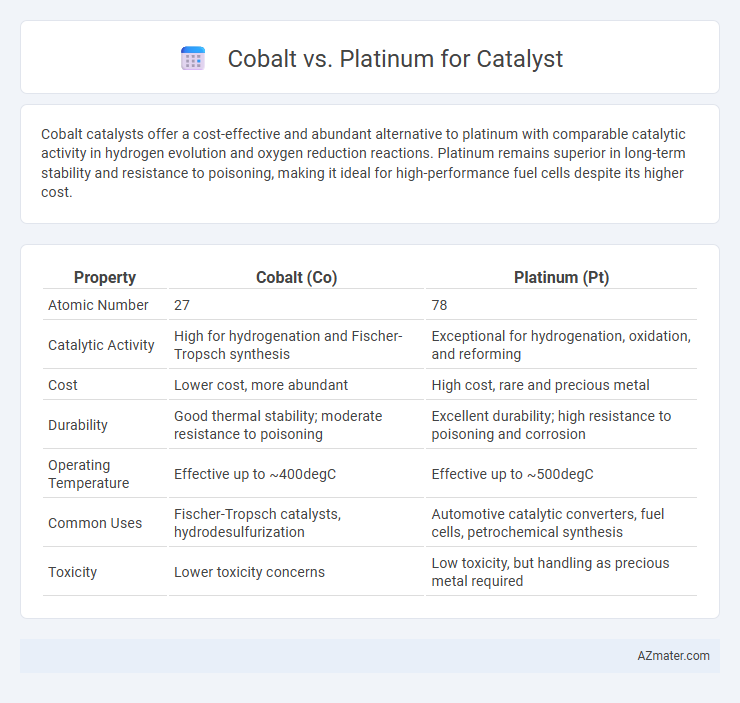Cobalt catalysts offer a cost-effective and abundant alternative to platinum with comparable catalytic activity in hydrogen evolution and oxygen reduction reactions. Platinum remains superior in long-term stability and resistance to poisoning, making it ideal for high-performance fuel cells despite its higher cost.
Table of Comparison
| Property | Cobalt (Co) | Platinum (Pt) |
|---|---|---|
| Atomic Number | 27 | 78 |
| Catalytic Activity | High for hydrogenation and Fischer-Tropsch synthesis | Exceptional for hydrogenation, oxidation, and reforming |
| Cost | Lower cost, more abundant | High cost, rare and precious metal |
| Durability | Good thermal stability; moderate resistance to poisoning | Excellent durability; high resistance to poisoning and corrosion |
| Operating Temperature | Effective up to ~400degC | Effective up to ~500degC |
| Common Uses | Fischer-Tropsch catalysts, hydrodesulfurization | Automotive catalytic converters, fuel cells, petrochemical synthesis |
| Toxicity | Lower toxicity concerns | Low toxicity, but handling as precious metal required |
Introduction to Cobalt and Platinum Catalysts
Cobalt catalysts exhibit strong activity in Fischer-Tropsch synthesis and hydrogenation reactions due to their high selectivity and cost-effectiveness compared to platinum. Platinum catalysts are widely used in automotive catalytic converters and fuel cells because of their exceptional stability, resistance to poisoning, and superior performance in oxidation and hydrogenation processes. The choice between cobalt and platinum catalysts depends on application-specific requirements including reaction conditions, catalyst lifetime, and economic factors.
Chemical Properties of Cobalt vs Platinum
Cobalt exhibits variable oxidation states, commonly +2 and +3, enabling versatile catalytic redox reactions, while platinum primarily exists in the +2 and +4 states, offering high stability and resistance to oxidation. The d-electron configuration of cobalt (3d7) facilitates strong interaction with reactant molecules, enhancing adsorption and catalytic activity, whereas platinum's 5d9 configuration provides superior electron density and excellent catalytic efficiency in hydrogenation and oxidation reactions. Cobalt's higher tendency for oxide formation contrasts with platinum's inert nature, making platinum more suitable for harsh environments and long-term catalyst durability.
Catalytic Efficiency Comparison
Cobalt catalysts often demonstrate higher catalytic efficiency in oxygen evolution reactions (OER) due to their superior electron transfer capabilities and lower overpotentials compared to platinum. Platinum excels in hydrogen evolution reactions (HER) with exceptional durability and lower activation energy but tends to be less efficient in OER applications, where cobalt-based catalysts outperform in terms of cost-effectiveness and activity. Catalytic efficiency in fuel cells and electrolyzers frequently favors cobalt in alkaline environments, whereas platinum remains preferred for acidic conditions and overall stability.
Cost Analysis: Cobalt vs Platinum
Cobalt catalysts typically offer a cost advantage over platinum due to their lower raw material prices and greater abundance in the Earth's crust. While platinum remains highly efficient and effective, its high market value and scarcity significantly increase overall catalyst costs. Economic decisions in industrial catalysis often favor cobalt when balancing performance with budget constraints.
Availability and Sourcing of Materials
Cobalt is more abundant and sourced primarily from the Democratic Republic of Congo, which controls over 70% of global production, whereas platinum is rarer and predominantly mined in South Africa and Russia. The geopolitical risks and ethical concerns surrounding cobalt mining impact its supply chain stability, while platinum's scarcity drives higher costs and limits widespread adoption. Both materials face challenges, but platinum's limited global reserves make its availability more constrained compared to cobalt's relatively larger resource base.
Environmental Impact and Sustainability
Cobalt-based catalysts generally offer higher activity and selectivity but pose significant environmental concerns due to toxic mining practices and limited supply, raising sustainability issues. Platinum catalysts, though less abundant and costly, provide greater recyclability and lower ecological footprints through established recovery processes and stable, long-term performance. Transitioning to platinum or cobalt-platinum alloys enhances catalytic efficiency while supporting reduced environmental impact and promoting sustainable resource utilization in industrial applications.
Industrial Applications of Cobalt Catalysts
Cobalt catalysts are widely used in industrial applications such as Fischer-Tropsch synthesis, hydroformylation, and hydrogenation due to their high activity and selectivity, especially in producing long-chain hydrocarbons and fine chemicals. Unlike platinum catalysts, which excel in hydrogenation and automotive catalytic converters, cobalt catalysts offer cost-effective solutions for large-scale chemical conversions involving syngas and olefin functionalization. The robustness and lower sensitivity to sulfur contamination of cobalt catalysts make them preferable for industrial processes requiring high catalytic stability and efficiency.
Industrial Applications of Platinum Catalysts
Platinum catalysts are highly valued in industrial applications for their superior catalytic activity, durability, and resistance to poisoning, especially in automotive catalytic converters and chemical synthesis processes such as nitric acid production. Compared to cobalt-based catalysts, platinum offers enhanced efficiency in hydrogenation reactions and reforming processes, leading to higher yield and selectivity. The high cost of platinum is offset by its long lifespan and consistent performance in harsh operating environments, making it indispensable in refining, petrochemical production, and pollution control technologies.
Challenges and Limitations
Cobalt catalysts often face challenges such as lower durability and susceptibility to oxidation compared to platinum, limiting their long-term stability in catalytic applications. Platinum, while highly efficient and resistant to deactivation, is hindered by high costs and limited availability, constraining large-scale deployment. Both metals present trade-offs between performance and economic feasibility, impacting their suitability for widespread catalytic use.
Future Trends in Catalyst Development
Cobalt catalysts are gaining traction in future catalyst development due to their cost-effectiveness and abundance compared to platinum, which remains highly efficient but expensive. Advances in nanostructuring cobalt catalysts are enhancing their activity and stability, narrowing the performance gap with platinum in applications like fuel cells and hydrogen production. Research is also exploring hybrid catalysts combining cobalt and platinum to optimize durability and catalytic performance, positioning these materials as key players in sustainable energy technologies.

Infographic: Cobalt vs Platinum for Catalyst
 azmater.com
azmater.com